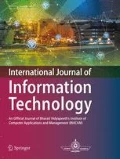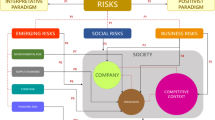Abstract
Despite the development of enterprise resource planning (ERP) deployments in the last two decades, organizations have also faced with implementation challenges. The present study provides a comprehensive categorization of these factors and the effective parameters using a meta-synthesis approach and with a systematic review of implementation risk factors and failure/success factors in the ERP literature. The most important factors were: Management of key stakeholder participation, project management and process management. The primary outcomes of this study which give it credit compared to similar reports were: (i) a new framework for ERP risk factors and their affecting parameters were introduced; (ii) a comprehensive ERP implementation checklist was attained; (iii) for the first time, parameters affecting ERP risk factors were identified and analyzed into organizational and national groups. Ultimately, organizational structure, IT maturity, human resources, organizational culture, and previous related experiences towards ERP were the most critical changeable organizational parameters that were recognized.












Similar content being viewed by others
References
Aloini D, Dulmin R, Mininno V (2012) Risk assessment in ERP projects. Inf Syst 37(3):183–199
Zeng Y (2010) Risk management for enterprise resource planning system implementations in project-based firms.
Chang B, Kuo C, Wu C-H, Tzeng G-H (2015) Using fuzzy analytic network process to assess the risks in enterprise resource planning system implementation. Appl Soft Comput 28:196–207
Davenport T, Short J (2000) In search of ERP paybacks. Computerworld 34(8):42
Panorama consulting solutions (2016) 2016 Report on ERP systems and enterprise software go.panorama-consulting.com/rs/panoramaconsulting/images/2016-ERP-Report.pdf.
Lincoln YS, Guba EG (1985) Naturalistic inquiry, vol 75. Sage.
Tummala VR, Nkasu M, Chuah K (1994) A framework for project risk management. ME Res Bull 2:145–171
Dey PK, Clegg B, Cheffi W (2013) Risk management in enterprise resource planning implementation: a new risk assessment framework. Product Plan Control 24(1):1–14
Grossman T, Walsh J (2004) Avoiding the pitfalls of ERP system implementation. Inf Syst Manag 21(2):38–42
Standard B (1991) BS 4778 (1991): Glossary of terms used in quality assurance (including reliability and maintainability). British Standards Institution, London
Hakim A, Hakim H (2010) A practical model on controlling the ERP implementation risks. Inf Syst 35(2):204–214
Huang S-M, Chang I-C, Li S-H, Lin M-T (2004) Assessing risk in ERP projects: identify and prioritize the factors. Ind Manag Data Syst 104(8):681–688
Pouransafar M, Cheperli M, Faraj Tabrizi MR (2013) Failure factors of ERP projects in an Iranian context. IOSR J Bus Manag 9(4):83–87
Leopoulos V, Kirytopoulos K, Voulgaridou D (2006) A model for risk identification in ERP system processes. WIT Trans Ecol Environ, 91
Mamoghli S, Goepp V, Botta-Genoulaz V, Renaud J (2011) An analysis of the “project” misalignment risk in ERP projects. IFAC Proc 44(1):13092–13097
Aloini D, Dulmin R, Mininno V (2007) Risk management in ERP project introduction: review of the literature. Inf Manag 44(6):547–567
Ojala M, Vilpola I, Kouri I (2006) Risks and risk management in ERP project-cases in SME context. In: Business Information Systems (BIS), Citeseer,
Lech P (2016) Causes and remedies for the dominant risk factors in Enterprise System implementation projects: the consultants’ perspective. SpringerPlus 5(1):238
Wiegers K (1998) Know your enemy: software risk management. Softw Dev-San Francisco 6:38–44
Tummala R, Schoenherr T (2011) Assessing and managing risks using the supply chain risk management process (SCRMP). Supply Chain Manag Int J 16(6):474–483
Tho I (2012) Managing the risks of IT outsourcing. Routledge,
Deng J, Bian Y Constructing a risk management mechanism model of ERP project implementation. In: Information Management, Innovation Management and Industrial Engineering, 2008. ICIII'08. International Conference on, 2008. IEEE, pp 72–77
Kaur K, Kaur A, Kaur R (2014) Study of different risk management model and risk knowledge acquisition with WEKA. Int J Eng Res General Sci, 2 (4)
The University of Vermont (2016) Guide to risk assessment and response.
Lewis-Beck M, Bryman AE, Liao TF (2003) The Sage encyclopedia of social science research methods. Sage Publications, Thousand Oaks
Erwin EJ, Brotherson MJ, Summers JA (2011) Understanding qualitative metasynthesis: issues and opportunities in early childhood intervention research. J Early Interv 33(3):186–200
Dixon-Woods M, Shaw RL, Agarwal S, Smith JA (2004) The problem of appraising qualitative research. BMJ Qual Saf 13(3):223–225
Major CH, Savin-Baden M (2010) An introduction to qualitative research synthesis: managing the information explosion in social science research. Routledge.
Wongpakaran N, Wongpakaran T, Wedding D, Gwet KL (2013) A comparison of Cohen’s Kappa and Gwet’s AC1 when calculating inter-rater reliability coefficients: a study conducted with personality disorder samples. BMC Med Res Methodol 13(1):61
Landis JR, Koch GG (1977) An application of hierarchical kappa-type statistics in the assessment of majority agreement among multiple observers. Biometrics 1977:363–374
Gwet KL (2014) Handbook of inter-rater reliability: The definitive guide to measuring the extent of agreement among raters. Advanced Analytics, LLC, California
Shanks G, Seddon PB, Willcocks LP (2003) Second-wave enterprise resource planning systems: implementing for effectiveness. Cambridge University Press, Cambridge
Iskanius P (2009) The ERP project risk assessment–A case study. In: Proceedings of the World Congress on Engineering, 2009. pp 1–3
Naeem S, Islam MH (2016) Information assurance for enterprise resource planning systems: risk considerations in public sector organizations. Mehran Univ Res J Eng Technol 35(4):483
Poba-Nzaou P, Raymond L, Fabi B (2008) Adoption and risk of ERP systems in manufacturing SMEs: a positivist case study. Bus Process Manag J 14(4):530–550
Sumner M (2000) Risk factors in enterprise-wide/ERP projects. J Inf Technol 15(4):317–327
Salimi F, Dankbaar B, Davidrajuh R (2006) A comprehensive study on the differences in ERP implementation between manufacturing and service industry. J Int Technol Inf Manag 15(3):2
Momoh A, Roy R, Shehab E (2010) Challenges in enterprise resource planning implementation: state-of-the-art. Bus Process Manag J 16(4):537–565
de Vries J, Boonstra A (2012) The influence of ERP implementation on the division of power at the production-sales interface. Int J Oper Product Manag 32(10):1178–1198
Pishdad A, Haider A (2013) ERP institutionalization: exploring the influential factors. J Enterprise Inf Manag 26(6):642–660
Sadat SN, Amini M, Abdollahzadegan A, Zakaria NH (2013) An effective model for evaluating organizational risk and cost in ERP implementation by SME.
Schniederjans D, Yadav S (2013) Successful ERP implementation: an integrative model. Bus Process Manag J 19(2):364–398
Seo G (2013) Challenges in implementing enterprise resource planning (ERP) system in large organizations: similarities and differences between corporate and university environment. Massachusetts Institute of Technology, Massachusetts
Ravasan AZ, Mansouri T (2014) A FCM-based dynamic modeling of ERP implementation critical failure factors. Int J Enterprise Inf Syst (IJEIS) 10(1):32–52
Abbasi S, Zamani M, Valmohammadi C (2014) The effects of ERP systems implementation on management accounting in Iranian organizations. Educ Bus Soc: Contemp Middle Eastern Issues 7(4):245–256
Garg P, Garg A (2014) Factors influencing ERP implementation in retail sector: an empirical study from India. J Enterprise Inf Manag 27(4):424–448
Ram J, Corkindale D (2014) How “critical” are the critical success factors (CSFs)? Examining the role of CSFs for ERP. Bus Process Manag J 20(1):151–174
Garg P, Chauhan A (2015) Factors affecting the ERP implementation in Indian retail sector: a structural equation modelling approach. Benchmark: Int J 22 (7):1315–1340
Nandi ML, Kumar A (2016) Centralization and the success of ERP implementation. J Enterprise Inf Manag 29(5):728–750
Baykasoğlu A, Gölcük İ (2017) Comprehensive fuzzy FMEA model: a case study of ERP implementation risks. Oper Res 2017:1–32
Al-Hadi MA, Al-Shaibany NA (2017) Critical success factors (CSFs) of ERP in higher education institutions. Int J 7(4):92–95
Baykasoğlu A, Gölcük İ (2017) Development of a two-phase structural model for evaluating ERP critical success factors along with a case study. Comput Ind Eng 106:256–274
Li H-J, Chang S-I, Yen DC (2017) Investigating CSFs for the life cycle of ERP system from the perspective of IT governance. Comput Stand Interfaces 50:269–279
Cyrus K, Aloini D, Karimzadeh S (2018) How to disable mortal loops of enterprise resource planning (ERP) implementation: a system dynamics analysis. Systems 6(1):3
Valanarasu R, Christy A (2018) Risk assessment and management in enterprise resource planning by advanced system engineering theory. Int J Bus Intell Data Mining 13(1–3):3–14
Barth C, Koch S (2019) Critical success factors in ERP upgrade projects. Ind Manag Data Syst 119(3):656–675
Menon S (2019) Effective strategies to overcome challenges in ERP Projects: perspectives from a Canadian exploratory study. Int Bus Res 12(7):12–23
Jurisch MC, Rosenberg Z, Krcmar H (2016) Emergent risks in business process change projects. Bus Process Manag J 22(4):791–811
Alsulami M, Scheepers H, Rahim MM (2016) A comparison between organizational Stakeholders’ and external Consultants’ Perceptions on CSFs affecting ERP life cycle phases. In: System Sciences (HICSS), 2016 49th Hawaii International Conference on, 2016. IEEE, pp 4676–4685
Grabski SV, Leech SA, Lu B (2001) Risks and controls in the implementation of ERP systems.
Tatsiopoulos IP, Panayiotou NA, Kirytopoulos K, Tsitsiriggos K (2003) Risk management as a strategic issue for the implementation of ERP systems: a case study from the oil industry. Int J Risk Assess Manag 4(1):20–35
Venkatesh J, Arthy C (2012) Threats in implementation of ERP applications. Int J Market, Financ Serv Manag Res, 1 (7)
Lee S, Kim D (2016) The effects of industry classification on a successful ERP implementation model. J Inf Process Syst, 12 (1)
Saade RG, Nijher H (2016) Critical success factors in enterprise resource planning implementation: a review of case studies. J Enterprise Inf Manag 29(1):72–96
Lopez C, Salmeron JL (2014) Dynamic risks modelling in ERP maintenance projects with FCM. Inf Sci 256:25–45
Nayebzadeh M, Saadatjoo F, Dehnavi HD (2014) Identifying and ranking factors affecting the successful implementation of ERP by using fuzzy delphi and fuzzy analytical hierarchy process. Int J Acad Res Bus Soc Sci 4(2):440
Huang Z, Palvia P (2001) ERP implementation issues in advanced and developing countries. Bus Process Manag J 7(3):276–284
Ojiako U, Papadopoulos T, Thumborisuthi C, Fan Yang Y (2012) Perception variability for categorised risk factors. Ind Manag Data Syst 112(4):600–618
Annamalai C, Ramayah T (2013) Does the organizational culture act as a moderator in Indian enterprise resource planning (ERP) projects? An empirical study. J Manuf Technol Manag 24(4):555–587
Elkhani N, Soltani S, Nazir Ahmad M (2014) The effects of transformational leadership and ERP system self-efficacy on ERP system usage. J Enterprise Inf Manag 27(6):759–785
Dezdar S, Ainin S (2011) The influence of organizational factors on successful ERP implementation. Manag Decis 49(6):911–926
Hwang D, Min H (2015) Identifying the drivers of enterprise resource planning and assessing its impacts on supply chain performances. Ind Manag Data Syst 115(3):541–569
Markus ML, Tanis C (2000) The enterprise systems experience-from adoption to success. Fram Domains IT Res: Glimpse Future Past 173:207–173
Bharathi V, Raman R, Pramod D (2014) A FPN based risk assessment model for ERP implementation in small and medium enterprises.
Ahmadi S, Yeh C-H, Papageorgiou EI, Martin R (2015) An FCM–FAHP approach for managing readiness-relevant activities for ERP implementation. Comput Ind Eng 88:501–517
Ravasan AZ, Nabavi A, Mansouri T (2015) Can organizational structure influence ERP success? Int J Inf Syst Supply Chain Manag (IJISSCM) 8(1):39–59
Zach O, Erik Munkvold B (2012) Identifying reasons for ERP system customization in SMEs: a multiple case study. J Enterprise Inf Manag 25(5):462–478
Katerattanakul PJ, Lee J, Hong S (2014) Effect of business characteristics and ERP implementation on business outcomes: an exploratory study of Korean manufacturing firms. Manag Res Rev 37(2):186–206
Christofi M, Nunes M, Chao Peng G, Lin A (2013) Towards ERP success in SMEs through business process review prior to implementation. J Syst Inf Technol 15(4):304–323
Marcelino-Sádaba S, Pérez-Ezcurdia A, Lazcano AME, Villanueva P (2014) Project risk management methodology for small firms. Int J Project Manag 32(2):327–340
Protiviti Inc. (2006) Guide to enterprise risk management: frequently asked questions
Kabaranzade M (2012) Alignment of production strategy with BPR in ERP implementation for performance measurement in continuous manufacturing industries. J Inf Technol Manag 4(11):93–110
Author information
Authors and Affiliations
Corresponding author
Rights and permissions
About this article
Cite this article
Zendehdel Nobari, B., Azar, A., Kazerooni, M. et al. Revisiting enterprise resource planning (ERP) risk factors over the past two decades: defining parameters and providing comprehensive classification. Int. j. inf. tecnol. 14, 899–914 (2022). https://doi.org/10.1007/s41870-020-00502-z
Received:
Accepted:
Published:
Issue Date:
DOI: https://doi.org/10.1007/s41870-020-00502-z




